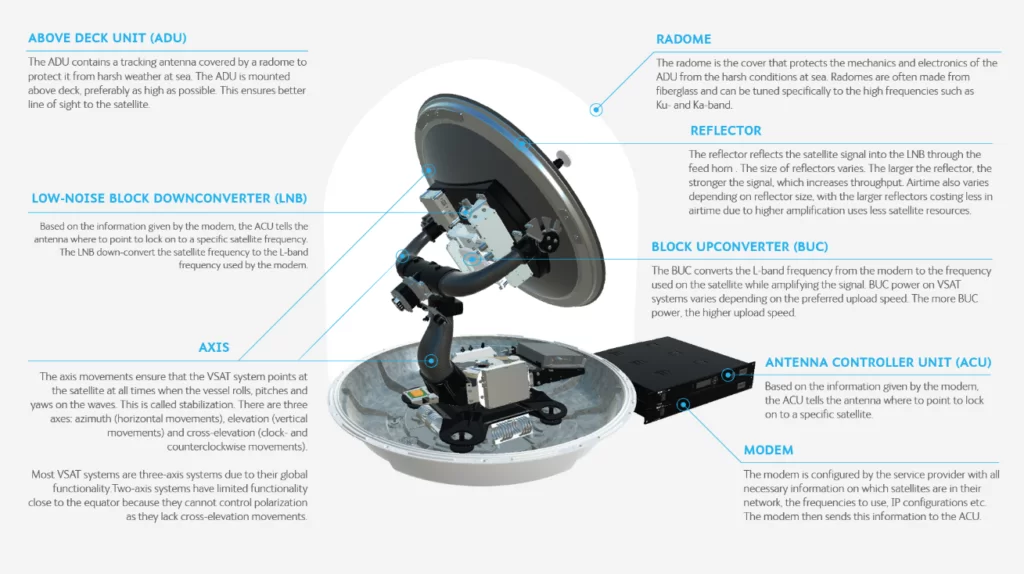Vessel: Navigating with Marine VSAT Technology – Enabling Seamless Connectivity at Sea
For mariners venturing into the expansive ocean, dependable communication isn’t merely a luxury but an operational necessity. Marine Very Small Aperture Terminal (VSAT) technology fills this crucial role, delivering internet connectivity even in the most remote maritime environments. This article delves into the realm of marine VSAT, exploring its advantages, applications, and critical considerations.
Introduction to Marine VSAT
Marine VSAT represents a satellite-based communication system tailored explicitly for maritime applications. It employs compact VSAT antennas mounted on vessels to establish bidirectional data transmission via geostationary satellites orbiting the Earth. Unlike terrestrial networks dependent on land-based infrastructure, marine VSAT ensures continuous connectivity virtually anywhere across global waters.

Advantages of Marine VSAT
- Uninterrupted Connectivity: Maintains seamless communication with crew, onshore offices, and families regardless of geographical location.
- Enhanced Safety: Enables swift communication during emergencies, enhancing response times for search and rescue operations.
- Optimized Operations: Facilitates real-time weather updates, route optimization, and remote fleet management, bolstering operational efficiency.
- Enhanced Productivity: Supports crew productivity through access to critical business applications and email services.
- Entertainment Options: Provides onboard Wi-Fi for crew welfare, fostering morale during extended voyages.

Applications of Marine VSAT
- Commercial Shipping: Crucial for cargo vessels, tankers, and container ships for operational efficiency, weather monitoring, and crew communication.
- Offshore Oil & Gas Industry: Facilitates data exchange between offshore platforms, support vessels, and onshore facilities, ensuring operational continuity.
- Luxury Yachts and Cruise Ships: Delivers internet access for passengers and crew, enhancing guest experience and crew welfare.
- Research and Survey Vessels: Supports data transmission, collaboration with land-based teams, and remote scientific research.
Selecting the Right Marine VSAT Solution
Choosing an optimal marine VSAT solution hinges on several factors:
- Vessel Specifications: Tailor the VSAT system to match vessel size and operational demands, from small craft to large cruise liners.
- Coverage Requirements: Ensure the VSAT service provider offers adequate coverage for planned maritime routes and operational areas.
- Bandwidth Considerations: Assess data transmission needs, including emails, video conferencing, and operational data, to determine appropriate bandwidth requirements.
- Budgetary Constraints: Evaluate VSAT solutions based on features, service plans, equipment costs, and ongoing operational expenses.


The Future Outlook for Marine VSAT
The future of marine VSAT appears promising, with advancements in satellite technology poised to deliver higher bandwidth, reduced latency, and expanded coverage areas. Integration with complementary maritime technologies such as navigation systems will further elevate safety and operational efficiency.
Conclusion
Embracing a robust marine VSAT solution empowers maritime operators to maintain connectivity, operational efficiency, and crew welfare across global seas. It stands as a pivotal tool for navigating modern maritime challenges with confidence and reliability.
FAQ – Marine VSAT (Very Small Aperture Terminal)
- What is Marine VSAT?
- Marine VSAT is a satellite communication system designed for maritime vessels, providing high-speed internet, voice, and data services globally.
- How does Marine VSAT operate?
- Marine VSAT establishes a two-way satellite link between the vessel’s VSAT terminal and geostationary satellites, enabling seamless data transmission and reception at sea.
- What components comprise a Marine VSAT system?
- A typical Marine VSAT system includes a VSAT antenna, below-deck modem, satellite modem, and associated cabling and networking infrastructure.
- What are the primary advantages of Marine VSAT over other communication systems?
- Marine VSAT offers high-speed broadband connectivity, global coverage, reliability, and support for multiple concurrent applications, meeting diverse maritime communication needs.
- Can Marine VSAT support voice communication?
- Yes, Marine VSAT systems facilitate Voice over Internet Protocol (VoIP) services, enabling high-quality voice communication similar to terrestrial telephony.
- Is Marine VSAT suitable for video streaming and conferencing?
- Yes, Marine VSAT provides ample bandwidth for video streaming, conferencing, and other bandwidth-intensive applications, enhancing crew welfare and operational efficiency.
- What factors should be considered when selecting a Marine VSAT provider?
- Considerations include coverage area, network reliability, bandwidth options, customer support, pricing, and additional services like cybersecurity and crew welfare solutions.
- How does Marine VSAT handle adverse weather conditions?
- Marine VSAT systems incorporate advanced stabilization technology to sustain connectivity during rough seas and severe weather, ensuring continuous communication.
- Can Marine VSAT integrate with onboard systems for remote monitoring and control?
- Yes, Marine VSAT seamlessly integrates with onboard systems for monitoring vessel operations, engine performance, navigation, and safety systems.
- What types of data usage plans are available for Marine VSAT services?
- Marine VSAT providers offer various data plans tailored to vessel types and usage needs, encompassing fixed-rate, capped, and flexible data options.
- Are there regulatory requirements or licensing for operating Marine VSAT?
- Vessels using Marine VSAT systems must adhere to regulatory mandates from maritime authorities and secure necessary licenses for satellite communication services.
- How does Marine VSAT contribute to crew welfare onboard vessels?
- Marine VSAT enables crew members to stay connected with families via internet access, social media, and communication apps, enhancing morale during extended maritime missions.
- Can Marine VSAT support vessel tracking and monitoring?
- Yes, Marine VSAT systems support vessel tracking and monitoring applications, providing real-time location data and operational status updates to fleet managers and shipowners.
- What cybersecurity measures safeguard Marine VSAT systems?
- Marine VSAT providers implement robust cybersecurity measures, including encryption, firewalls, intrusion detection, and regular updates, to mitigate cyber threats and ensure system security.
- What technical support services are available for Marine VSAT systems?
- Marine VSAT service providers offer 24/7 technical support, onsite maintenance, remote diagnostics, and firmware updates to optimize system performance and reliability.
